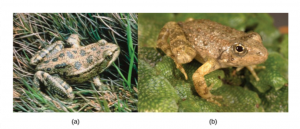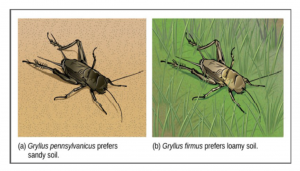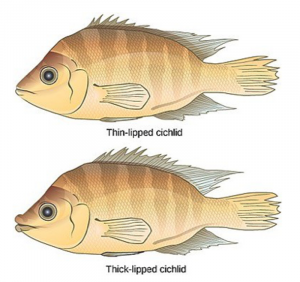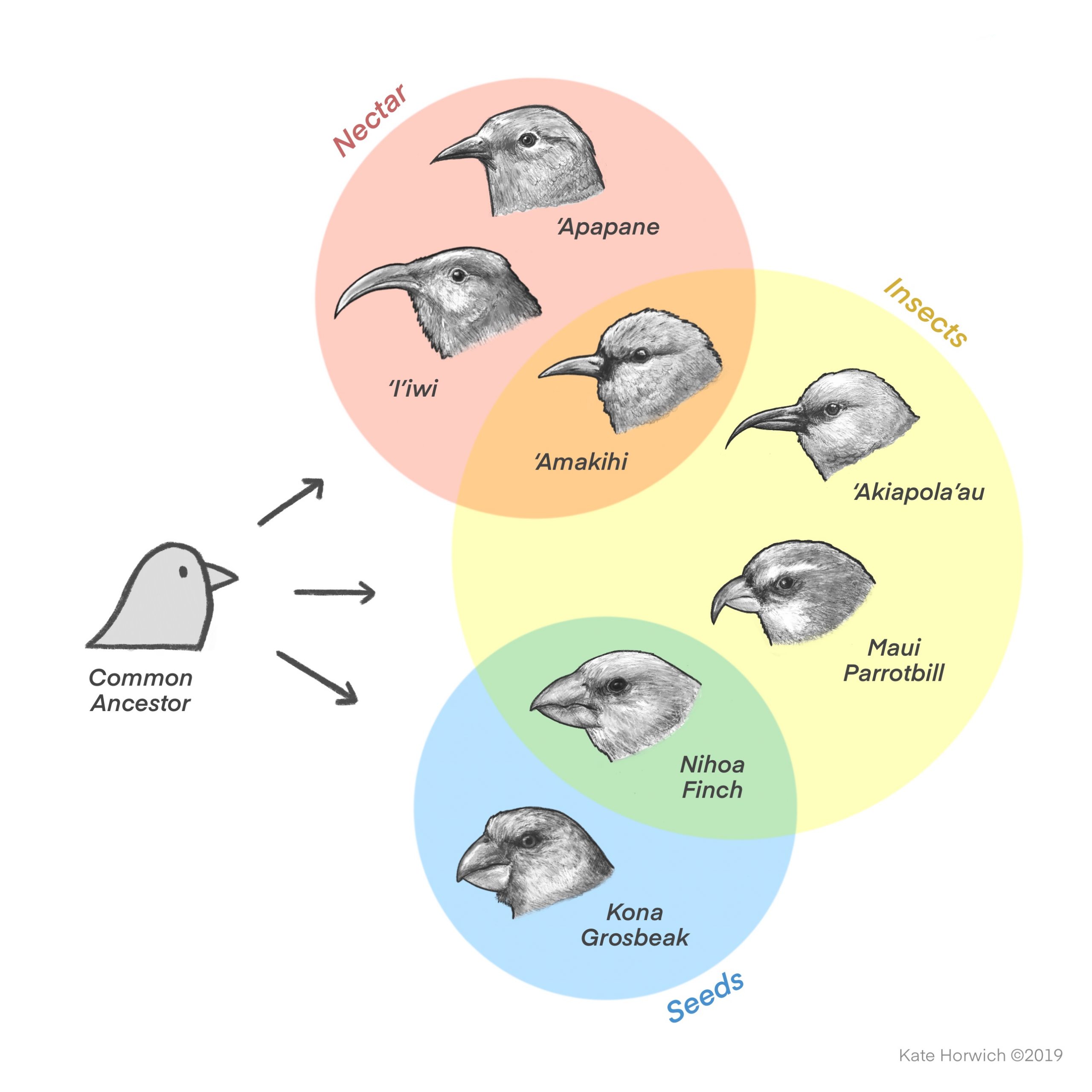8
Learning Goals
- Identify prezygotic and postzygotic reproductive barriers
- Discuss the role of habitat in the process of speciation
- Describe the process of adaptive radiation
Introduction
For speciation to occur, two new populations must form from one original population and they must evolve in such a way that it becomes impossible for individuals from the two new populations to interbreed. Biologists think of speciation events as the splitting of one ancestral species into two descendant species. However, there is no reason why more than two species might not form at one time except that it is less likely and multiple events are most likely single splits occurring close in time.
Reproductive Isolation
Given enough time, the genetic and phenotypic divergence between populations will affect characters that influence reproduction: if individuals of the two populations were brought together, mating would be less likely, but if mating occurred, offspring would be nonviable or infertile. Many types of diverging characters may affect the reproductive isolation, the ability to interbreed, of the two populations. Scientists organize the means of reproductive isolation into two groups: prezygotic barriers and postzygotic barriers. Recall that a zygote is a fertilized egg: the first cell of a sexually reproducing organism’s development. Therefore, a prezygotic barrier is a mechanism that blocks reproduction from taking place, thus no zygote is formed. A postzygotic barrier occurs after zygote formation. This includes organisms that don’t survive the embryonic stage and those that are born sterile.
Prezygotic Barriers

Some types of prezygotic barriers prevent reproduction entirely. Many organisms only reproduce at certain times of the year, often just annually. Differences in breeding schedules, which we call temporal isolation, can act as a form of reproductive isolation. For example, two frog species inhabit the same area, but one reproduces from January to March; whereas, the other reproduces from March to May (Fig. 1).

In some cases, sub-populations of a species move or are moved to a new habitat and that no longer overlaps with the same species’ original population. Reproduction with the parent species ceases, and a new group exists that is now reproductively and genetically independent. We call this situation habitat isolation. For example, a cricket population that was divided after a flood could no longer interact with each other (Fig. 2). Over time, natural selection forces, mutation, and genetic drift will likely result in the two groups diverging. The habitats need not be far apart for reproduction isolation to occur.
Behavioral isolation occurs when the presence or absence of a specific behavior prevents reproduction. For example, male fireflies use specific light patterns to attract females. Various firefly species display their lights differently. If a male of one species tried to attract the female of another, she would not recognize the light pattern and would not mate with the male.

Other prezygotic barriers work when differences in their gamete cells (eggs and sperm) prevent fertilization from taking place. This is gametic isolation and occurs after mating but before the formation of a zygote. In some cases, closely related organisms try to mate, but their reproductive structures simply do not fit together. This is mechanical isolation that prevents reproduction. For example, damselfly males of different species have differently shaped reproductive organs. If one species tries to mate with the female of another, their body parts simply do not fit together (Fig. 3).
In plants, certain structures aimed to attract one type of pollinator simultaneously prevent a different pollinator from accessing the pollen. The tunnel through which an animal must access nectar can vary widely in length and diameter, which prevents the plant from cross-pollinating with a different species.
Postzygotic Barriers
When fertilization takes place and a zygote forms, postzygotic barriers can prevent reproduction in the resulting organisms. Hybrid individuals in many cases cannot form normally in the womb and simply do not survive past the embryonic stages. We call this hybrid inviability because the hybrid organisms simply are not viable. In another postzygotic situation, reproduction leads to hybrid birth and growth that is sterile. Such is the case in plants where autopoylploidy and allopolyploidy can impact the ability of individuals to produce viable offspring. When the organisms are unable to reproduce offspring of their own it is referred to as hybrid sterility.
Review Question:
Two species of wild lettuce grow in the same area; however, one species flowers in early spring and the other flowers during the summer. What is this an example of?
A) Hybrid sterility
B) Temporal isolation
C) Habitat isolation
D) Hybrid inviability
E) Gametic isolation
Habitat Influence on Speciation

Sympatric speciation may also take place in response to the environment in which the population lives. For example, consider a fish species that lives in a lake. As the population grows, competition for food increases. Under pressure to find food, suppose that a group of these fish had the genetic flexibility to discover and feed off another resource that other fish did not use. What if this new food source was located at a different depth of the lake? Over time, those feeding on the second food source would interact more with each other than the original population of fish; therefore, they would be most likely to breed within their group rather than with the original population. Offspring of this subpopulation of fish would likely behave as their parents: feeding and living in the same area and keeping separate from the original population. If this group of fish continued to remain separate from the first population, eventually sympatric speciation might occur as more genetic differences accumulated between them.
An example of this scenario in nature occurred in Cichlid fish from Lake Apoyeque, Nicaragua. Lake Apoyeque is a crater lake that is 1800 years old where genetic evidence indicates that a single population of cichlid fish populated the lake only 100 years ago. In this lake, two types of cichlids live in the same geographic location but have come to have different morphologies that allow them to eat various food sources (Fig. 4). Presently only the two populations with distinct morphologies and diets now exist in the lake, but scientists believe these populations may be in an early stage of additional speciation events.
Adaptive Radiation

In some cases, a population of one species disperses throughout an area, and each finds a distinct niche or isolated habitat. Over time, the varied demands of their new lifestyles lead to multiple speciation events originating from a single species. We call this adaptive radiation because many adaptations evolve from a single point of origin; thus, causing the species to radiate into several new ones. Island archipelagos like the Hawaiian Islands provide an ideal context for adaptive radiation events because water surrounds each island which leads to geographical isolation for many organisms. The Hawaiian honeycreeper illustrates one example of adaptive radiation. From a single species, the founder species, numerous species have evolved. Notice the differences in the species’ beaks in Figure 5. Responses to natural selection based on specific food sources available in each new habitat led to evolution of different beaks suited to the specific food sources. The seed-eating bird has a thicker, stronger beak which is suited to break hard nuts. The nectar-eating birds have long beaks to dip into flowers to reach the nectar. The insect-eating birds have beaks like swords, appropriate for stabbing and impaling insects.
When they are in the same geographic area speciation can be the result of habitat differences, behavioral differences, and/or differential ability to use resources. Changes in the populations can result in the evolution of traits that create reproductive barriers. If the trait results in lack of the ability to form an embryo, such as gametic isolation or temporal isolation, they are referred to a prezygotic mechanism. If the result is an infertile or inviable offspring then it is a post-zygotic isolation. These reproductive isolating mechanisms can eventually lead to the formation of new species.
Summary
It is not always necessary for a population or populations to be geographically isolated for them to speciate. When they are in the same geographic area speciation can be the result of habitat differences, behavioral differences, and/or differential ability to use resources. Changes in the populations can result in the evolution of traits that create reproductive barriers. If the trait results in a lack of the ability to form an embryo, such as gametic isolation or temporal isolation, they are referred to as a prezygotic mechanism. If the result is an infertile or inviable offspring then it is postzygotic isolation. These reproductive isolating mechanisms can eventually lead to the formation of new species.
End of Section Review Questions:
Review: Mechanisms of Speciation
1) Speciation can occur through a variety of mechanisms. Match the correct term to the appropriate description.
| Term | Description | |
| 1) Prezygotic isolation | A. the isolation of two or more populations because of the rise of a geographic barrier within a single population | |
| 2) Vicariance | B. a population of one species disperses throughout an area and different members adapt to unique niches/habitats | |
| 3) Adaptive Radiation | C. that prevent reproduction prior to embryo formation | |
| 4) Dispersal |
D. mechanisms that prevent offspring from reproducing (make them infertile) |
|
| 5) Postzygotic isolation | E. some individuals from the main population colonize a distant place |
Review: Adaptive Radiation
2) What are some of the key aspects of adaptive radiation?
A) Specialization of groups of individuals to specific habitats/niches
B) the presence of multiple ancestral species
C) multiple speciation events occurring
D) a single speciation event that occurs rapidly
Attribution
This material was adapted by D. Jennings from OpenStax Biology 2nd Edition, Biology 2e. OpenStax CNX. Nov 26, 2018 http://cnx.org/contents/8d50a0af-948b-4204-a71d-4826cba765b8@15.1.
Figure 1. Temporal Isolation in frogs: courtesy of CNX OpenStax / CC BY 4.0credit a: modification of work by Mark R. Jennings, USFWS; credit b: modification of work by Alessandro Catenazzi
Figure 2. Habitat isolation in crickets: courtesy of CNX OpenStax / CC BY 4.0
Figure 3. Mechanical Isolation in Damselflies courtesy of CNX OpenStax / CC BY 4.0
Figure 4. Speciation in Cichlid fishes courtesy of CNX OpenStax / CC BY 4.0
Figure 5. Honeycreeper Adaptive Radiation: courtesy of CNX OpenStax / CC BY 4.0

